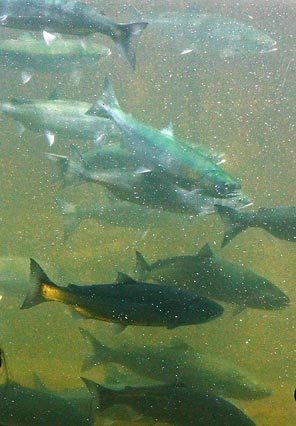forum
library
tutorial
contact

A Record Summer for Returning Sockeye
by Associated PressSan Diego Union-Tribune, July 26, 2008
|
the film forum library tutorial contact |

|
A Record Summer for Returning Sockeyeby Associated PressSan Diego Union-Tribune, July 26, 2008 |
 PORTLAND, Ore. - Sockeye salmon are heading back up the Columbia River this summer in numbers unseen since 1955, and nobody is sure why.
PORTLAND, Ore. - Sockeye salmon are heading back up the Columbia River this summer in numbers unseen since 1955, and nobody is sure why.
Some credit a federal court order releasing extra water over dams in 2006 and 2007 to ease the young salmons' passage to the sea, The Oregonian reported. Others cite improved ocean conditions.
But the returning numbers exceed any year since the last major dam was built on the Columbia or Snake rivers. Sockeye were close to being written off in parts of the Northwest's largest river system. Fish counters have recorded the return of nearly 215,000 sockeye, or red, salmon through Tuesday.
Most are headed upriver to Washington's Wenatchee and Osoyoos lakes. A few others, representing the river system's most endangered run, are going to Lower Granite Dam on the Snake River. That run is nearly complete. The count of returning adult sockeye headed for Lower Granite topped 800 through Tuesday.
It is the largest sockeye return recorded at Lower Granite since it was built in 1975, and nearly 25 times the average return of the last 10 years. Ten years ago two sockeye came back.
The Snake River sockeye was the first population to be listed as endangered on the Columbia system 17 years ago.
The large return follows relatively good returns of spring chinook to the Columbia and good early indications on steelhead.
The sockeye is the third most common species of Pacific salmon, after pink and chum salmon, and is valued by commercial fishermen because of its flavor and the bright color that makes it attractive to canners.
The name is thought to be a derivative of "sukkai," its name in some river tribal languages.
Ocean conditions have improved, including more nutrient-rich upwelling. Sockeye hatcheries on both rivers have increased output.
The Columbia Basin Fish Passage Center credits the spike to the dam spills and increased hatchery releases.
Michele DeHart, the Portland-based center's manager, said her analysis indicates survival of juvenile sockeye headed to the ocean in 2006 and 2007 improved significantly after U.S. District Court Judge James Redden ordered more spill for fish in late 2005. The better flows speed the fish's trip to the ocean, she said.
"The fish are telling us something as to what set of conditions works for them," DeHart said. "Sockeye like a lot of flow and they like spill."
Sports fishermen want Redden to force the agencies to continue elevated springtime spills, which cost the Bonneville Power Administration millions of dollars in lost hydroelectric power generation.
Federal agencies proposed a new plan this year for running the dams in a fish-friendly way after Redden rejected two prior efforts.
Oregon Gov. Ted Kulongoski criticized the plan, saying it is not significantly different from the others.
"I think most fishery scientists are of the mind that the primary influence is the ocean," said Brian Gorman, a spokesman for the National Marine Fisheries Service. "It's going to require some thoughtful analysis, rather than a knee-jerk reaction."
DeHart said ocean conditions have been good in the past but the fish still did poorly because of poor river conditions.
Paul Kline, assistant fisheries bureau chief for the Idaho Department of Fish and Game, said the next question is how many make it past Lower Granite another 462 miles up the Salmon River to the lakes in central Idaho.
The fish are due to start arriving within days, he said. But the mortality rate from the Lower Granite dam has been as high as 75 percent in past years, partly because of high stream temperatures and a widespread parasite.
Wild sockeye are smaller than chinook and coho. They thrive by the millions in Alaska and British Columbia, but have struggled in the Northwest.
The Snake River sockeye faced intense commercial fishing in the 1880s. By 1910, a dam was closing off much of their range. In the 1950s and 1960s they were replaced with trout in three key Idaho lakes. Then came the lower Snake River dams.
By the time the Snake River sockeye were listed as endangered in 1991 there was no self-sustaining, naturally spawning population.
Smolt released from government hatcheries are set to increase substantially.
learn more on topics covered in the film
see the video
read the script
learn the songs
discussion forum
